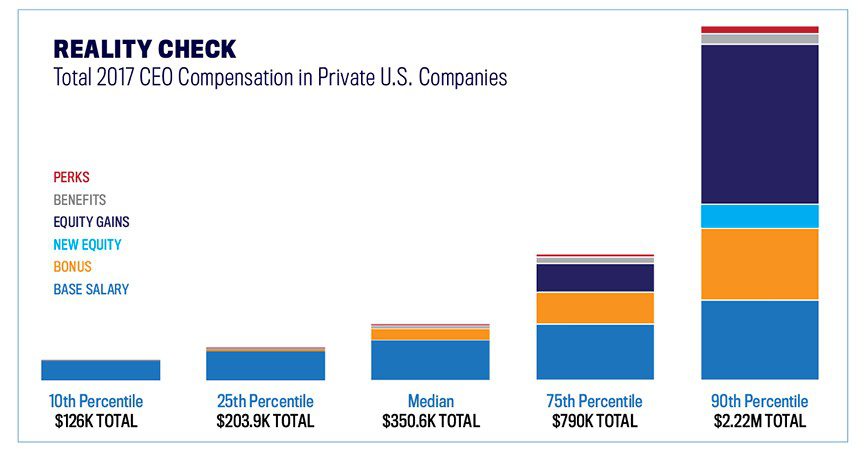
 Detailed information on salaries, bonuses, equity grants, benefits, perks, as well as how these elements vary by company size, industry, ownership type, geographic region and other variables is available in the full 2018-2019 CEO & Senior Executive Compensation Report for Private Companies: CompReport.ChiefExecutive.net.
Detailed information on salaries, bonuses, equity grants, benefits, perks, as well as how these elements vary by company size, industry, ownership type, geographic region and other variables is available in the full 2018-2019 CEO & Senior Executive Compensation Report for Private Companies: CompReport.ChiefExecutive.net.
Daffodils. Baseball. Allergies. Reports on CEO pay. Ah, the rites of spring in America.
Over the weekend, The Wall Street Journal published it’s annual look at what the CEOs of the biggest U.S. companies earn, setting up some of the usual hand wringing over how much is too much when it comes to chief executive pay. For the record, they found median pay for the bosses of S&P 500 companies at $12.4 million last year, up 6.6% from 2017 and the highest since the 2008 recession.
On Friday, it was The New York Times chiming in with their overbroad and eye-roll inducing headline (“It’s Never Been Easier to Be a C.E.O., and the Pay Keeps Rising”)—a whopping generalization that conflates the earning of just the top 200 CEOs with the take-home of all US CEOs.

But look at data for all U.S. CEOs—as we do each year—and you get a different story. Chief Executive Research surveyed 1,631 private companies in April through June of 2018 about their 2017 fiscal year compensation levels and practices, as well as their current and expected compensation levels for senior executives for the remainder of 2018. (Detailed data from this survey is analyzed and presented in our annual CEO & Senior Executive Compensation Report for Private Companies.)
The median private company CEO total compensation package for 2017? $350,622. For the record, that’s just 6.7 times the median income for all U.S. workers, not 275 times, as some have said.
That’s worth noting, especially as we head into a 2020 election where CEOs and their pay are highly scrutinized, of the roughly 30 million businesses in the United States, fewer than 6,000 are publicly traded and only the largest 8 percent of these public companies make it into the S&P 500.
For those keeping score, that’s 0.002 percent of all U.S. companies.




Chief Executive Group exists to improve the performance of U.S. CEOs, senior executives and public-company directors, helping you grow your companies, build your communities and strengthen society. Learn more at chiefexecutivegroup.com.
0

1:00 - 5:00 pm
Over 70% of Executives Surveyed Agree: Many Strategic Planning Efforts Lack Systematic Approach Tips for Enhancing Your Strategic Planning Process
Executives expressed frustration with their current strategic planning process. Issues include:
Steve Rutan and Denise Harrison have put together an afternoon workshop that will provide the tools you need to address these concerns. They have worked with hundreds of executives to develop a systematic approach that will enable your team to make better decisions during strategic planning. Steve and Denise will walk you through exercises for prioritizing your lists and steps that will reset and reinvigorate your process. This will be a hands-on workshop that will enable you to think about your business as you use the tools that are being presented. If you are ready for a Strategic Planning tune-up, select this workshop in your registration form. The additional fee of $695 will be added to your total.

2:00 - 5:00 pm
Female leaders face the same issues all leaders do, but they often face additional challenges too. In this peer session, we will facilitate a discussion of best practices and how to overcome common barriers to help women leaders be more effective within and outside their organizations.
Limited space available.

10:30 - 5:00 pm
General’s Retreat at Hermitage Golf Course
Sponsored by UBS
General’s Retreat, built in 1986 with architect Gary Roger Baird, has been voted the “Best Golf Course in Nashville” and is a “must play” when visiting the Nashville, Tennessee area. With the beautiful setting along the Cumberland River, golfers of all capabilities will thoroughly enjoy the golf, scenery and hospitality.
The golf outing fee includes transportation to and from the hotel, greens/cart fees, use of practice facilities, and boxed lunch. The bus will leave the hotel at 10:30 am for a noon shotgun start and return to the hotel after the cocktail reception following the completion of the round.